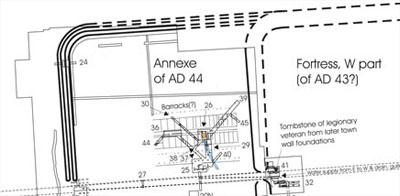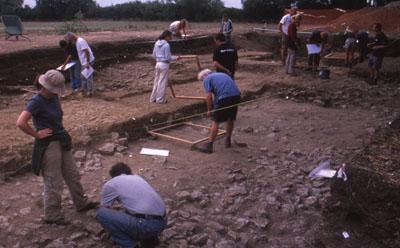Alchester: shedding new light on the Roman invasion of Britain
Archaeological fieldwork in Oxfordshire, directed by Edinburgh’s Professor Eberhard Sauer, revealed more than a previously-unknown Roman fortress. It shed new light on the speed and manner of Roman conquest in AD 43.

The systematic examination of a waterlogged military site at Alchester between1996 and 2004 uncovered extensive fortifications - but also evidence of trade and other benefits for local people.
The findings suggest that pacification of southern Britain required greater military efforts than previously recognised, and offered exciting insights into the origins, evolution and occupants of Oxfordshire’s largest Roman town.
Military occupation
The combined size of the main fortress and its large annex would have amounted to 14-15 hectares.
There was evidence for dense, multi-phase military occupation in the mid-first century. Anti-personnel devices, in the form of sharpened stakes at the approaches to a timber gate, suggest an army well prepared for potential rebellion.
Yet the interrelation between conquerors and the native population was complex.
Trade benefits
Domestic animals of typically indigenous breeds were consumed within the fortress. It is not known whether they had been bought or requisitioned but the circulation of Iron Age coinage suggests that the army and Britain’s native population engaged in commerce.
Alchester was supplied by flowing water as early as the AD 40s. New foods were introduced, such as coriander and millet. There was even a modicum of literacy.
Earliest fortress – and a tantalising tombstone

Tree rings dated the gate posts at the site to AD 44/45, making them the earliest in Britain.
An inscribed tombstone of Lucius Valerius Geminus, a veteran of the Second Augustan Legion, provided the first known pre-medieval biography of a person living and dying in the Oxfordshire area.
The significance of this find, a clue as to the local garrison, raised even more exciting possibilities. The Second Legion’s commander at the time was Vespasian, who later went on to become emperor (AD 69-79).
Capturing popular imagination
Britain’s earliest dated Roman timbers are now the subject of a case study in the widely-read textbook, ‘Archaeology: An introduction’ by Kevin Greene.
Forty articles have been published about the project (UK and overseas) and the discovery of Lucius’s tombstone was featured in The Times and on local television.
Artefacts uncovered at the site have been seen by thousands of people, thanks to the Oxfordshire Museums Resource Centre at Standlake.

